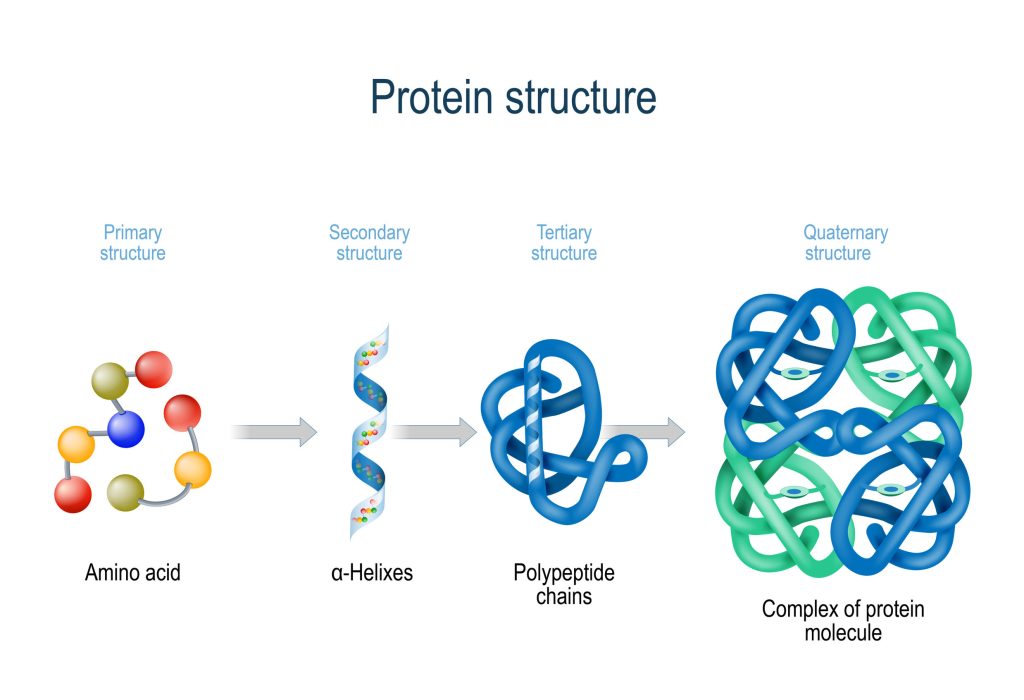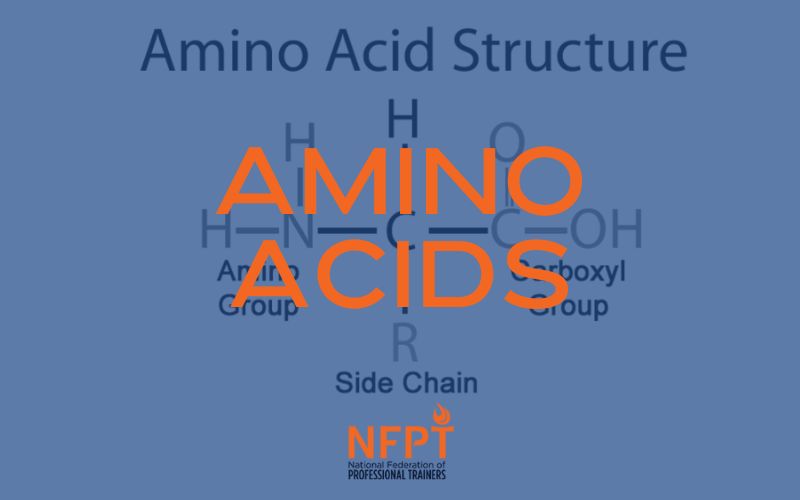Amino acids, often referred to as the “building blocks of protein” are abundant in nature and in the foods we eat. While the term itself may be familiar, every personal trainer who is well-versed in how they are utilized in protein synthesis and muscle growth will be better equipped to advise their clients.
Amino Acids Fundamentals
An amino acid is “any of a group of organic molecules that consist of a basic amino group (―NH2), an acidic carboxyl group (―COOH), a hydrogen atom (H) and an organic R group (or side chain) that is unique to each amino acid.” Central to these groups is one carbon atom.1

After amino acids have been taken up into muscle tissue, they serve two basic purposes in hypertrophy.
The first, and most essential, is to become cellular catalysts. Such catalysts are used at the intracellular level, such as transcribing proteins. Their rate of depletion is directly associated with both the amount and the duration of the cellular work they perform.
Without these catalysts, muscle fibers would be unable to function. In any of a group of organic molecules that consist of a basic amino group (―NH2), an acidic carboxyl group (―COOH), and an organic R group (or side chain) that is unique to each amino acid. order of precedence, then, the body values amino acids as catalyst replacements over their use as material for tissue repair.
It is this secondary function, that of the body’s use of “surplus” amino acids as building blocks to fashion and repair bodily tissues, that is achieved through the process of protein synthesis.
Amino Acids: The Basics of Protein
Proteins are often referred to as the “building blocks” of the body, and for good reason. Unlike other macronutrients that can be “turned over” internally, there needs to be an incoming supply of this raw material to make up any amount lost through the process of degradation. Since the body cannot store the individual amino acids that make up proteins, it collects them and exchanges them among the liver, the blood, and in the spaces surrounding individual muscle fibers, known as interstitial spaces.
Protein Structure
Amino acids rarely serve a function on their own and are most often put to work in combinations. From a chemical standpoint, all of them contain an amino group (NH2) with an acid end (COOH), and some component that sets them apart from each other. Some of these latter components include glucogenic groups, some contain sulfur and some are known as branched-chain aminos, based on their chemical structure. While there have been 300 amino acids identified, there are 20 unique amino acids present in the human body and utilized for protein synthesis, ten of which are essential for bodily function in adults and cannot be synthesized by the body2.
These 10 are:
- Phenylalanine
- Valine
- Threonine
- Tryptophan
- Isoleucine
- Methionine
- Histidine
- Arginine
- Leucine
- Lysine
As a practical matter, histidine and arginine are required by infants and growing children. The amino acids leucine, isoleucine, and valine are believed to account for approximately 60% of muscle tissue. Consequently, it is believed that it is these amino acids that are most readily taken up and converted into catalysts, sparing other amino acids in the process for use in protein synthesis and in energy production.
A protein containing essential amino acids is known as a “complete protein“. If one or more of those amino acids are missing, it is known as an “incomplete protein“.

Levels of protein structure from amino acids to Complex of protein molecule. Protein is a polymer (polypeptide) that forms from sequences of amino acids. Levels of protein structure: Primary, Secondary, Tertiary, and Quaternary
While many people are concerned about the ratio of complete proteins in their meals or the ratio of complementary proteins, it is important to realize the body can draw from a pool of amino acids within a given muscle.
Exercise Duration & Catalyst Depletion
If a given exercise lasts too long, the supply of ready-formed catalysts is exhausted and the cells turn to converting amino acids that had been previously destined for use in protein synthesis. This is because the catalyst function is necessary for survival, while protein synthesis can wait as far as the body is concerned. In other words, the body will preferentially utilize amino acids for essential functions, versus non-essential functions.
The amino acids that have already been absorbed in the tissues are the first up for use as catalysts. If there is an insufficient amount of amino acids, the muscle tissue itself will be used through a process known as gluconeogenesis. From a training perspective, this constitutes overtraining and an effort should be made to avoid it.
Avoiding Catalyst Depletion
Perhaps the easiest way to sidestep the issue of catalyst depletion altogether is ensure that your personal training client consumes an adequate amount of calories every 3 to 4 hours. Since the body’s “go-to” source of energy is carbohydrates, it is important that he or she consumes an amount of carbohydrate sufficient to spare protein.
If adequate protein is not consumed, which is often the case among clients and especially women, 19% of whom underconsume recommended amounts of protein3, studies indicate that supplementing with amino acids can reduce exercise-induced fatigue, and presumably, the catabolism associated with gluconeogenesis; specifically, L-arginine, L-valine and L-serine supplementation in this case.
As a calorie-free and purportedly more bioavailable than protein shakes, i.e., the amino acids are more readily absorbed than those in a protein shake, amino acid supplements are widely available to the public such as Perfect Amino*. I and several of my clients who have taken these supplements report increased energy during workouts and recovery time post-workout when taking this product. It is worth noting that their blend is proprietary and the ratio of amino acids listed is unknown.
In addition to nutritive considerations, the workout itself should not be overly exertive. This will allow for the availability of sufficient post-workout recovery catalysts and energy being the process of anabolism in which the body grows new cells and maintains tissues, and slows the process of continued catabolism, or tissue breakdown.
Certainly, post-workout nutrition is important to take into consideration and should be explored with each training client based on their personal lifestyle needs.
*affiliate link
References
- www.britannica.com/science/amino-acid
- www.researchgate.net/publication/260210809_Amino_acids_A_review_article
- www.frontiersin.org/articles/10.3389/fnut.2020.00076/full
- aminoacidsguide.com/#google_vignette
- www.ncbi.nlm.nih.gov/pmc/articles/PMC6893825/
NFPT Publisher Michele G Rogers, MA, NFPT-CPT and EBFA Barefoot Training Specialist manages and coordinates educational blogs and social media content for NFPT, as well as NFPT exam development. She’s been a personal trainer and health coach for over 20 years fueled by a lifetime passion for all things health and fitness. Her mission is to raise kinesthetic awareness and nurture a mind-body connection, helping people achieve a higher state of health and wellness. After battling and conquering chronic back pain and becoming a parent, Michele aims her training approach to emphasize fluidity of movement, corrective exercise, and pain resolution. She holds a master’s degree in Applied Health Psychology from Northern Arizona University. Follow Michele on Instagram.


